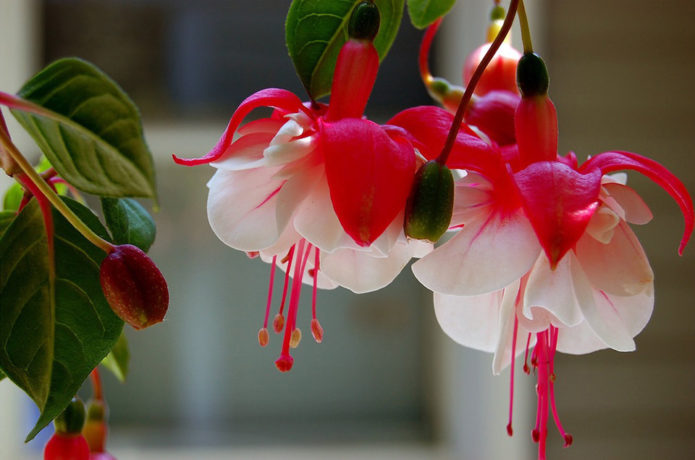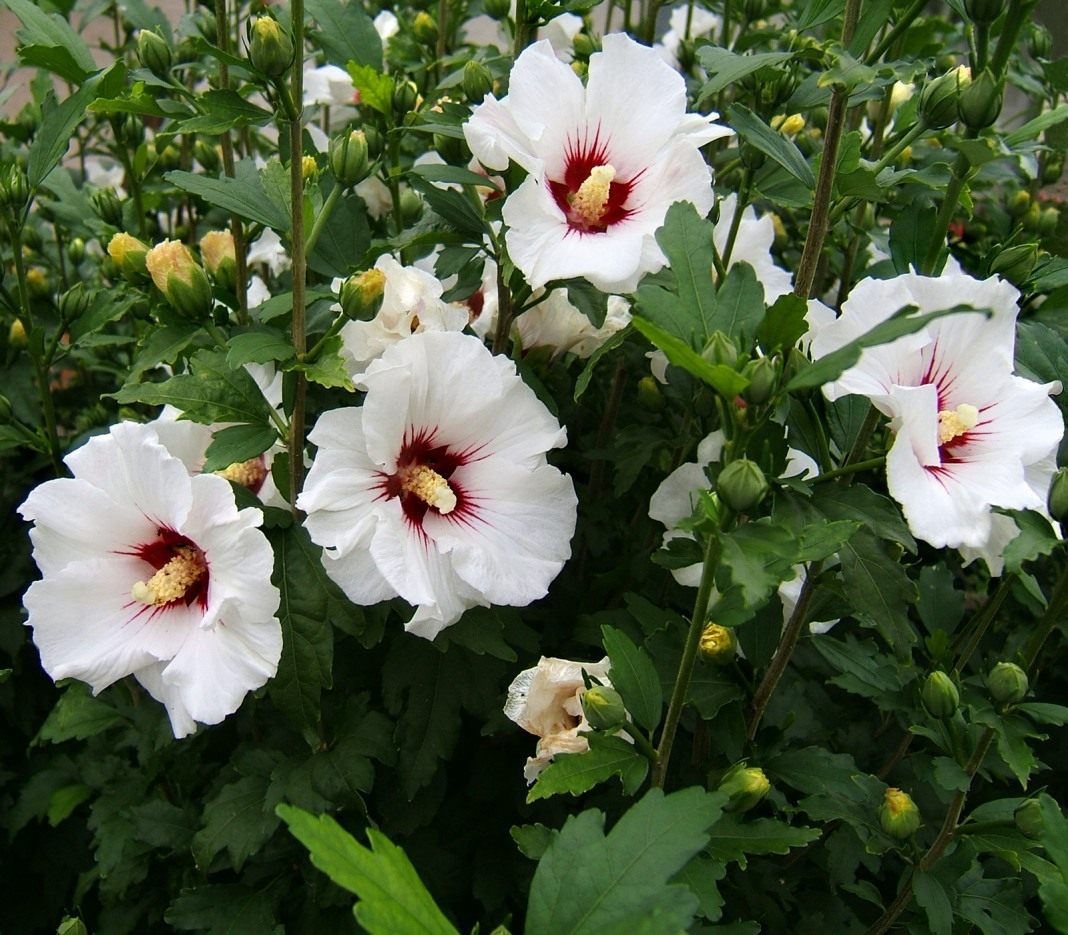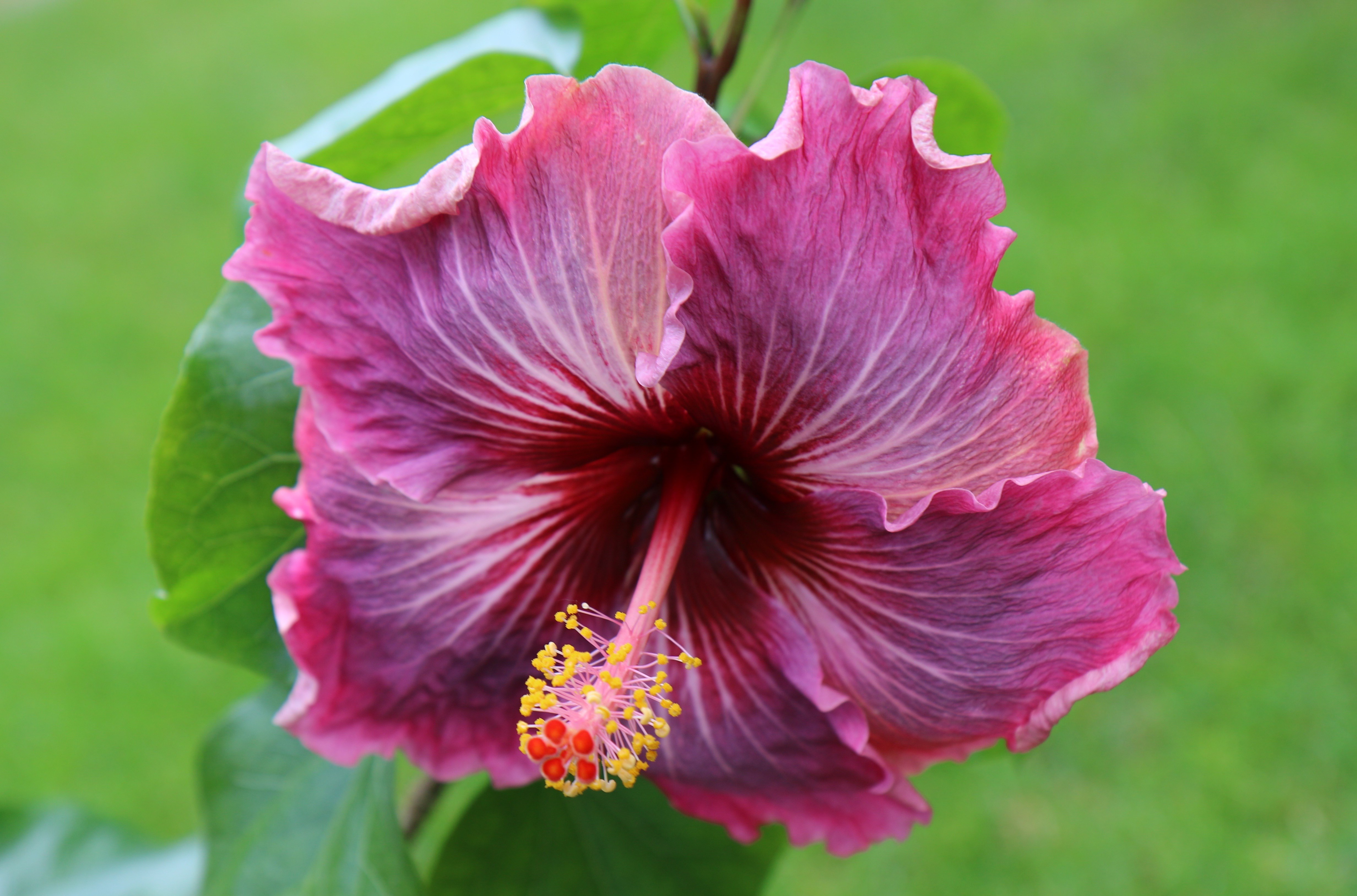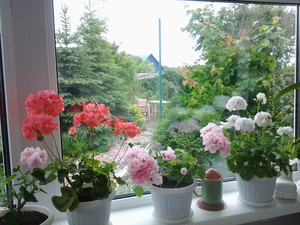 Even the simplest interior takes on a sophisticated look if it is decorated with greenery. It is much better to put a tall palm tree or a beautiful bush in a free corner than another bedside table with trinkets. And how flowers cheer you up!
Even the simplest interior takes on a sophisticated look if it is decorated with greenery. It is much better to put a tall palm tree or a beautiful bush in a free corner than another bedside table with trinkets. And how flowers cheer you up!
There are a huge number of indoor plants of the most diverse in shape and shade. Unpretentious flowers for an apartment can grow in a dry, dusty and shaded room. They do not need special care and do not take long for this.
Content
Types of indoor flowers blooming all year round
Every housewife wants the plants not to require complicated care, and at the same time pleasing the eye with their flowering as long as possible. There are quite a few of them. Here are the most interesting ones:
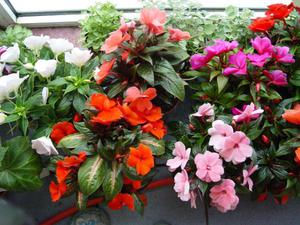 Geranium (pelargonium).
Geranium (pelargonium).- Begonia.
- Balsam.
- Fuchsia.
- Abutilon.
- Spathiphyllum.
- Hibiscus.
- Anthurium.
- Clivia.
These tenants, blooming all year round, can be purchased at any store. They will "forgive" their owner for any mistakes, but still, there are subtleties in caring for each of them. The beauty and duration of flowering depends on them.
You should pay attention to the following points:
- how light-loving, thermophilic and moisture-loving the plant is;
- is there a difference in flower care in winter and summer;
- how to transplant a resident of an apartment;
- in what soil the flower will feel best.
Geranium (pelargonium)
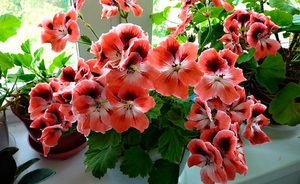 In fact, the correct name for geranium is pelargonium. Real geranium is a gardener, not an indoor dweller. The confusion in the names happened so long ago that no one remembers it anymore. And all because pelargonium could be found literally in every home.
In fact, the correct name for geranium is pelargonium. Real geranium is a gardener, not an indoor dweller. The confusion in the names happened so long ago that no one remembers it anymore. And all because pelargonium could be found literally in every home.
Has a pungent odorwhich repels insects and cleans the air of bacteria. If you are near a blooming geranium for a long time, you may get a headache.
- The peculiarity of this plant is its love for sunlight. Often it is impossible to water pelargonium - its roots can rot. At the same time, in summer, watering should be abundant, but infrequent, and in winter, dry maintenance is necessary.
- If the room where the pelargonium is located has a normal room temperature, then it will delight with flowering all year round, with the exception of December-January.
- Pelargonium can grow over time. In this case, as well as for the formation of a beautiful crown, it is necessary to trim, or pinch. You should know that Pelargonium does not like pruning too often.
- Pelargonium can be propagated by seeds, but at home it is propagated by cuttings. To do this, cut off the apical shoot and root it. Young pelargonium is transplanted and reloaded every year in the spring, before intensive growth begins.
- The best soil for pelargonium is a mixture of turf, humus, leafy soil, and sand. The pot should not be very large, otherwise shoots with leaves will develop strongly, and there will be no flowering.
Florists brought many varieties of pelargonium, different colors and different smells. You can always choose the perfect variety for the interior.
Begonia
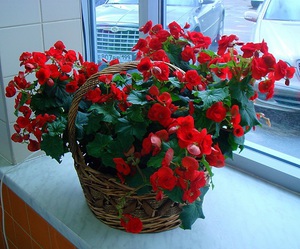 Begonia is an extremely unpretentious plant. It blooms so profusely that it is reflected in the Latin name for begonia - begonia semperflorens.It translates as “always blooming begonia". With a caring attitude, begonia will bloom all year round without interruption.
Begonia is an extremely unpretentious plant. It blooms so profusely that it is reflected in the Latin name for begonia - begonia semperflorens.It translates as “always blooming begonia". With a caring attitude, begonia will bloom all year round without interruption.
Begonia light-requiring, undemanding to soil and temperature conditions. In summer, you can take it out to the balcony and leave it there overnight without fear.
Planting begonias is also very simple: cut off a stalk and put it in water. After a few days, the cutting will take root, after which it can be planted in a pot. You can trim the begonia to be more bushy.
Balsam
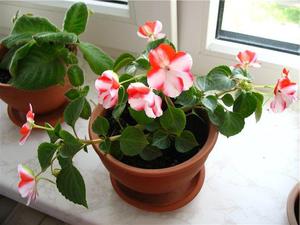 Balsam is colloquially called "light". Its single, large flowers have long, curved spurs. During the flowering period, the leaves are almost invisible behind the flowers, from a distance it seems that there is not a plant in the pot, but small bright light... And balsam blooms for a very long time - from June to October.
Balsam is colloquially called "light". Its single, large flowers have long, curved spurs. During the flowering period, the leaves are almost invisible behind the flowers, from a distance it seems that there is not a plant in the pot, but small bright light... And balsam blooms for a very long time - from June to October.
Balsam is photophilous, but does not tolerate bright sunlight. You cannot put it where the sun is directly shining. He is hygrophilous, on hot days you need him spray with water... He loves warmth, but not heat (from +15 to +25 degrees).
According to the conditions of detention, it is ideal for urban apartments, in which, as a rule, there are no extreme weather conditions. He feels great under artificial lighting.
You just need to make sure that they do not stand too close to each other. In this case, they can shed their leaves. Leaves can also fall off from cold and lack of light.
It is better to propagate balsam by cuttings removed from the top (about 3 cm long). Cuttings will root in any solution or substrate. The best soil for balsam is a mixture of humus and leafy earth with a small amount of sand added.
When the age of the balsam reaches 3-4 years, it is better to transplant it, because young plants bloom more abundantly than old ones.
Fuchsia
Fuchsia feels great in rooms with artificial light. It blooms richly from early spring to late autumn. During this time, fuchsia can be kept on the balcony or in the garden.
For flowering to be longer, after the first flowers fall, trim them and feed. Fuchsia should be watered rarely in winter, and often and abundantly in summer.
When fuchsia hibernates, it sheds its leaves, and by spring it is again covered with them. Fuchsia definitely needs rest, otherwise it will bloom badly during the season.
During flowering do not rearrange the pots, move them from place to place. The plant can shed its buds.
The easiest way to propagate fuchsia is with large, mature leaves with strong petioles. Pull the leaf off the stem with a precise and sharp movement. A bud will sprout from the bottom of the petiole, which will develop into an adult plant.
Fuchsia is unpretentious to the soil, but it feels best in a mixture of leafy earth, black soil, peat and sand (sand is half as much as the rest of the components).
Abutilon
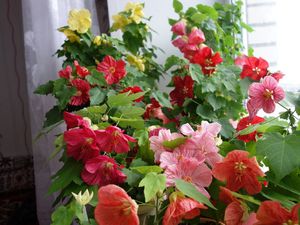 Due to the characteristic shape of the leaves, it is called indoor maple... It is a surprisingly unpretentious household dweller, requiring only regular but moderate watering and constant lighting.
Due to the characteristic shape of the leaves, it is called indoor maple... It is a surprisingly unpretentious household dweller, requiring only regular but moderate watering and constant lighting.
To make the flowering more persistent and long-lasting, abutilone can be fed with potassium nitrate and superphosphate. In the spring he strong pruning needed - by one third or even half of all shoots.
Abutilone propagates by cuttings in spring or summer, and the best soil for it is turf, humus, leafy earth with a small addition of sand.
Spathiphyllum
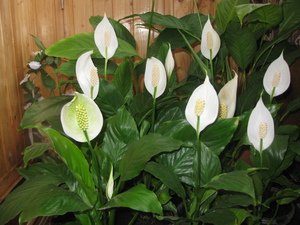 Spathiphyllum profusely flowering, or flagleaf, is valued not only for its ease of care, but also for unusual snow-white flowers with a delicate aroma. They are even grown for cutting (they can stand in water for a long time).
Spathiphyllum profusely flowering, or flagleaf, is valued not only for its ease of care, but also for unusual snow-white flowers with a delicate aroma. They are even grown for cutting (they can stand in water for a long time).
Spathiphyllum is thermophilic (optimal temperature is 25-27 degrees), otherwise caring for it is common. It is almost impossible to dry it, as well as to pour. Spathiphyllum likes humid air (85-90%) and lack of direct sunlight.
If the conditions are not entirely suitable for him, he will not die, but it will simply be worse to bloom. Spathiphyllum is propagated by dividing the bush into 2-3 parts.Each of the divided parts must have roots.
Better to plant a young plant in small pots filled with a mixture of peat, humus, leafy ground and sand (in equal parts) and add some charcoal, tree bark and crushed brick to the soil.
Hibiscus or chinese rose
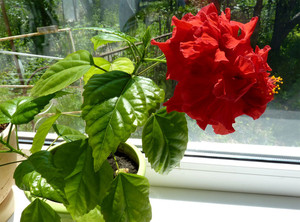 Hibiscus is an undemanding evergreen shrub that can grow from one to two meters in height under indoor conditions. From early spring to late autumn, it is showered with large, fiery red, white or pink flowers.
Hibiscus is an undemanding evergreen shrub that can grow from one to two meters in height under indoor conditions. From early spring to late autumn, it is showered with large, fiery red, white or pink flowers.
Place the hibiscus in a sunny place. In summer, it requires abundant watering and feeding. In winter, it is better to keep hibiscus at a temperature of 16-17 degrees.
Hibiscus propagates by cuttings. In water or sand, they instantly take root. The rose feels best in soil from turf, humus and peat, with the addition of a small amount of sand.
Young plants are replanted every spring, and adults - after a few years (depending on the capacity of the pot and the nutritional value of the soil). In spring, hibiscus can be pruned to form a bush and form young shoots on which flowers grow.
Anthurium
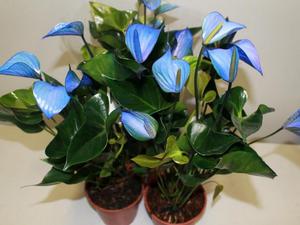 There are many varieties of anthurium. They are divided into two groups: flowering and decorative deciduous... When buying, you should pay attention to this.
There are many varieties of anthurium. They are divided into two groups: flowering and decorative deciduous... When buying, you should pay attention to this.
All the charm of anthuriums lies in the veil that surrounds their center. It is curved and leathery, bright red, pink, crimson, and less often white.
Anthurium is photophilous, a comfortable temperature for it is not lower than +18 degrees. Watering should be avoided when watering. Anthuriums love spraying.
Anthuriums are planted by cuttings or by separating lateral shoots with roots (this is the easiest way). The soil must be well drained. It is best to mix leafy, peaty, coniferous soil in equal parts, and add a little sand and charcoal.
Clivia
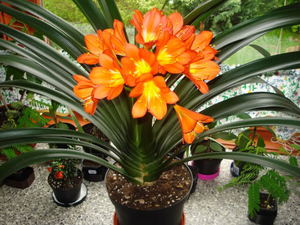 Clivia is a flower with dark green elongated leaves. During flowering, a long arrow appears from the bottom of the leaf with large yellow-orange buds, similar to bells, the number of which can reach 30 pieces.
Clivia is a flower with dark green elongated leaves. During flowering, a long arrow appears from the bottom of the leaf with large yellow-orange buds, similar to bells, the number of which can reach 30 pieces.
Clivia is shade-tolerant. If you feed her a little with mineral fertilizers, then even in the darkest room she will bloom profusely at the end of winter, in spring, and then, after a short break, in summer.
Root offspring always appear near an adult plant, with which the clivia is propagated. They are carefully separated from their parent and planted in soil from a mixture of turf, sand and leafy soil.
